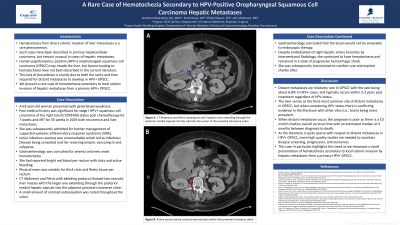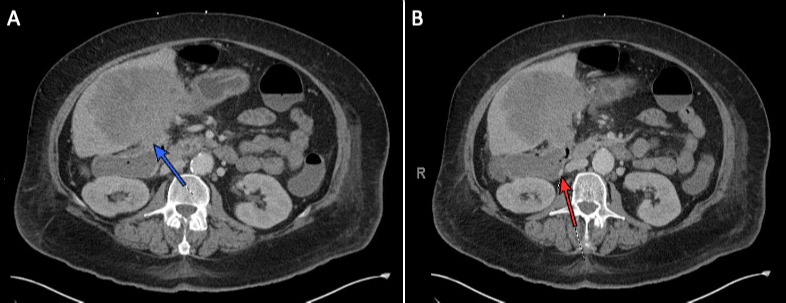Monday Poster Session
Category: GI Bleeding
P2092 - A Rare Case of Hematochezia Secondary to HPV-Positive Oropharyngeal Squamous Cell Carcinoma Hepatic Metastases
Monday, October 23, 2023
10:30 AM - 4:15 PM PT
Location: Exhibit Hall

Has Audio

Jonathan Rozenberg, DO, MPH
Virginia Tech Carilion School of Medicine
Roanoke, VA
Presenting Author(s)
Jonathan Rozenberg, DO, MPH1, Parth Desai, DO2, Philip Elbaum, DO3, John Altomare, MD3
1Virginia Tech Carilion School of Medicine, Roanoke, VA; 2Tower Health-Reading Hospital, Reading, PA; 3Tower Health-Reading Hospital, West Reading, PA
Introduction: Hematochezia from direct colonic invasion of liver metastases is a rare phenomenon. Such cases have been described in primary hepatocellular carcinoma, but remain unusual in cases of hepatic metastases. Human papillomavirus positive (HPV+) oropharyngeal squamous cell carcinoma (OPSCC) may invade the liver, but lesions leading to hematochezia have not been described. This is mainly due to both the rarity and time required for distant metastases to develop in HPV+ OPSCC. We present a rare case of hematochezia secondary to local colonic invasion of hepatic metastases from a primary HPV+ OPSCC.
Case Description/Methods: A 63-year-old woman presented with generalized weakness. Past medical history was significant for stage I HPV+ squamous cell carcinoma of the right tonsil (T2N1M0) status post chemotherapy for 7 weeks and XRT for 35 weeks in 2019 with recurrence and liver metastases. Gastroenterology was consulted for anemia and new onset hematochezia. She had reported bright red blood per rectum with clots and active bleeding. Physical exam was notable for thick clots and fleshy tissue per rectum. CT abdomen and pelvis with bleeding protocol showed two necrotic liver masses with the larger one extending through the posterior medial hepatic capsule into the adjacent proximal transverse colon (figure 1). A small amount of contrast extravasation was noted throughout the colon. Despite IR embolization of right hepatic artery branches, she continued to have hematochezia and remained in a state of progressive hemorrhagic shock. She was subsequently transitioned to comfort care and expired shortly after.
Discussion: Distant metastases are relatively rare in OPSCC with the rate being about 6-8% in HPV+ cases, and typically occurs within 2-3 years post treatment regardless of HPV status. The liver serves as the third most common site of distant metastases in OPSCC, but when considering HPV status there is conflicting evidence in the literature with other sites (i.e., brain) being more prevalent. When distant metastases occur, the prognosis is poor with an estimated median of 4 months between diagnosis to death. This case highlights an unusual manifestation of HPV-positive OPSCC hepatic metastases.

Disclosures:
Jonathan Rozenberg, DO, MPH1, Parth Desai, DO2, Philip Elbaum, DO3, John Altomare, MD3. P2092 - A Rare Case of Hematochezia Secondary to HPV-Positive Oropharyngeal Squamous Cell Carcinoma Hepatic Metastases, ACG 2023 Annual Scientific Meeting Abstracts. Vancouver, BC, Canada: American College of Gastroenterology.
1Virginia Tech Carilion School of Medicine, Roanoke, VA; 2Tower Health-Reading Hospital, Reading, PA; 3Tower Health-Reading Hospital, West Reading, PA
Introduction: Hematochezia from direct colonic invasion of liver metastases is a rare phenomenon. Such cases have been described in primary hepatocellular carcinoma, but remain unusual in cases of hepatic metastases. Human papillomavirus positive (HPV+) oropharyngeal squamous cell carcinoma (OPSCC) may invade the liver, but lesions leading to hematochezia have not been described. This is mainly due to both the rarity and time required for distant metastases to develop in HPV+ OPSCC. We present a rare case of hematochezia secondary to local colonic invasion of hepatic metastases from a primary HPV+ OPSCC.
Case Description/Methods: A 63-year-old woman presented with generalized weakness. Past medical history was significant for stage I HPV+ squamous cell carcinoma of the right tonsil (T2N1M0) status post chemotherapy for 7 weeks and XRT for 35 weeks in 2019 with recurrence and liver metastases. Gastroenterology was consulted for anemia and new onset hematochezia. She had reported bright red blood per rectum with clots and active bleeding. Physical exam was notable for thick clots and fleshy tissue per rectum. CT abdomen and pelvis with bleeding protocol showed two necrotic liver masses with the larger one extending through the posterior medial hepatic capsule into the adjacent proximal transverse colon (figure 1). A small amount of contrast extravasation was noted throughout the colon. Despite IR embolization of right hepatic artery branches, she continued to have hematochezia and remained in a state of progressive hemorrhagic shock. She was subsequently transitioned to comfort care and expired shortly after.
Discussion: Distant metastases are relatively rare in OPSCC with the rate being about 6-8% in HPV+ cases, and typically occurs within 2-3 years post treatment regardless of HPV status. The liver serves as the third most common site of distant metastases in OPSCC, but when considering HPV status there is conflicting evidence in the literature with other sites (i.e., brain) being more prevalent. When distant metastases occur, the prognosis is poor with an estimated median of 4 months between diagnosis to death. This case highlights an unusual manifestation of HPV-positive OPSCC hepatic metastases.

Figure: Image 1: Panel A) CT showing necrotic hepatic mass extending through the posterior medial capsule (blue arrow) into the wall into the lumen of the proximal transverse colon. B) Active venous phase contrast extravasation (red arrow) within the proximal transverse colon
Disclosures:
Jonathan Rozenberg indicated no relevant financial relationships.
Parth Desai indicated no relevant financial relationships.
Philip Elbaum indicated no relevant financial relationships.
John Altomare indicated no relevant financial relationships.
Jonathan Rozenberg, DO, MPH1, Parth Desai, DO2, Philip Elbaum, DO3, John Altomare, MD3. P2092 - A Rare Case of Hematochezia Secondary to HPV-Positive Oropharyngeal Squamous Cell Carcinoma Hepatic Metastases, ACG 2023 Annual Scientific Meeting Abstracts. Vancouver, BC, Canada: American College of Gastroenterology.
